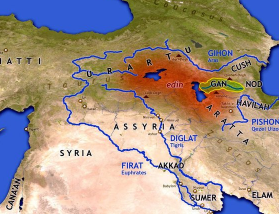The account that seems most clear is this one:
"And the Lord God planted a garden eastward in Eden; and there he put
the man whom he had formed." Genesis 2:7 A.V.
Eden was a named area (named by God), and at the east side of it, God planted a garden. This garden was in the eastern part of the land of Eden. Here is an insightful comment on the place where God placed the first man:
"First, the place was in Eden. Next, what distinguished it was the
planting of Jehovah Elohim. 'There he put the man whom he had
formed.' It was not simply Eden. Eden was larger than the garden. The
garden was part of Eden. Eden was not the garden. The garden was in
Eden. It was called The Garden of Eden, but it occupied the east only.
Eden itself stretched to the north, south, east and west. This area
was above and beyond the garden which Jehovah Elohim had planted
'Eastward in Eden', Genesis 2:8.
"...Here is an exact location. Here Jehovah Elohim chose to locate,
and wrought to plant, the garden of Eden. The present location - even
if it could be estimated since the Fall and after the universal
destruction of the Flood, which it cannot - is immaterial."
Creation, John Metcalfe, pp.93-94 & 98
Interestingly, verse 10 speaks of a river that went out of Eden, to water the garden, implying that the course of that river would be through Eden to the garden, exiting both Eden and the garden on the eastern boundary. From that river, four heads arose, to spread out into the world.
However, the reason you give for asking about east, or west, causes pause for thought. The same author (above) continues:
"The garden in which Adam had been put was eastward. Immediately such
an aspect referred the man to the place from whence light breaks
forth: from the East. As if to say daily, More light is to come."
(Ibid. p. 99)
Another author writes:
"After Adam's banishment, the cherubs were settled at the east of the
garden, which was at the east end of Eden. I see progress, here. The
original planting of the garden was towards the east. Now at its
extremity, is seen something...
In the cool of the day, the day in which man transgressed and the day
in which he must, therefore, die; as the day wanes, as the created sun
begins its descent towards darkness - then, God is in motion... The
moving God first settles the cherubs at the east of the garden of
Eden... The sun sinks into the west. And so it shall be through
thirty nine books of scripture until, in the very last few words, does
Malachi, the Messenger, prophesy thus - 'But unto you that fear my
name shall the sun of Righteousness arise with healing in his wings'
(4:2)...
But now [in the east of Eden] the cherubim preserve that single area
of light - the area that represents future redemption. The kerubim
wait for the rising of the sun in the east. They wait in Eden, the
place of witness; the area of testimony." The Cherubim of Glory,
Nigel Johnstone, pp. 20, 21 & 24, Belmont Publications, 2015
Yes, the biblical use of that word of direction - east - is full of spiritual meaning, very much so with the Temple of God. However, a new question would need to be asked to progress understanding of that. For this question, the answer is, "The garden was planted in the east of the land of Eden."
